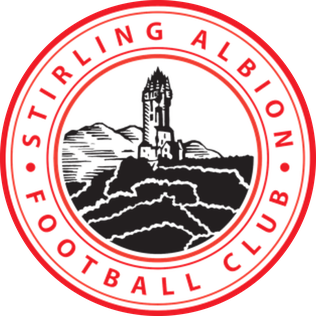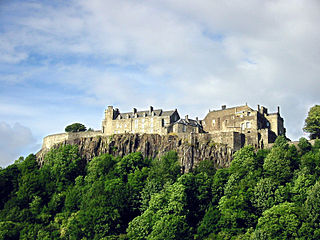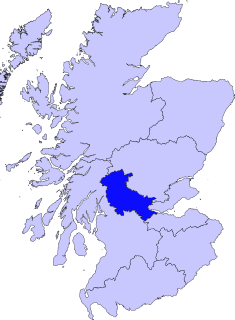
The Battle of Stirling Bridge was a battle of the First War of Scottish Independence. On 11 September 1297, the forces of Andrew Moray and William Wallace defeated the combined English forces of John de Warenne, 6th Earl of Surrey, and Hugh de Cressingham near Stirling, on the River Forth.

Stirling is a city in central Scotland, 26 miles (42 km) northeast of Glasgow and 37 miles (60 km) north-west of Edinburgh. The market town, surrounded by rich farmland, grew up connecting the royal citadel, the medieval old town with its merchants and tradesmen, the Old Bridge and the port. Located on the River Forth, Stirling is the administrative centre for the Stirling council area, and is traditionally the county town of Stirlingshire. Proverbially it is the strategically important "Gateway to the Highlands".

The University of Stirling (Scots: University o Stirlin, Scottish Gaelic: Oilthigh Shruighlea is a public university in Stirling, Scotland, founded by Royal Charter in 1967. It is located in the Central Belt of Scotland, built within the walled Airthrey Castle estate. Since its foundation, it has expanded to four faculties, a Management School, and a number of institutes and centres covering a broad range of subjects in the academic areas of arts and humanities, natural sciences, social sciences, and health sciences and sport.

Stirling Castle, located in Stirling, is one of the largest and most important castles in Scotland, both historically and architecturally. The castle sits atop Castle Hill, an intrusive crag, which forms part of the Stirling Sill geological formation. It is surrounded on three sides by steep cliffs, giving it a strong defensive position. Its strategic location, guarding what was, until the 1890s, the farthest downstream crossing of the River Forth, has made it an important fortification in the region from the earliest times.

Bannockburn is an area immediately south of the centre of Stirling in Scotland. It is part of the City of Stirling. It is named after the Bannock Burn, a burn running through the town before flowing into the River Forth.

The River Forth is a major river in central Scotland, 47 km (29 mi) long, which drains into the North Sea on the east coast of the country. Its drainage basin covers much of Stirlingshire in Scotland's Central Belt. The Gaelic name for the upper reach of the river, above Stirling, is Abhainn Dubh, meaning "black river". The name for the river below the tidal reach is Uisge For.

Stirlingshire or the County of Stirling, Scottish Gaelic: Siorrachd Sruighlea) is a historic county and registration county of Scotland. Its county town is Stirling.

The Stirling council area is one of the 32 council areas of Scotland, and has a population of about 94,330. It was created under the Local Government etc (Scotland) Act 1994 with the boundaries of the Stirling district of the former Central local government region, and it covers most of Stirlingshire and the south-western portion of Perthshire. Both counties were abolished for local government purposes under the Local Government (Scotland) Act 1973.

Stirling Albion Football Club is a Scottish football club based in the city of Stirling. The club was founded in 1945 following the demise of King's Park after World War II. The club currently competes in Scottish League Two as a member of the Scottish Professional Football League. Its highest league position came in 1958–59 with a 12th-placed position in the top flight. Its only major success is in the league where it has won the second tier of Scottish football on four occasions, the last coming in 1964–65. The club has more recently competed in the third or fourth tier following league re-construction in 1975 and 2013.
Alex Smith MBE is a Scottish former football player and manager. His major achievements over close to five decades as a manager include winning the Scottish Cup in 1987 with St Mirren and 1990 with Aberdeen, where he also won the Scottish League Cup in 1989. He had a role in the development of many prominent players, and the 2005 book on Scottish football, The Final Whistle? was described as "the nearest thing the Scottish game has to a father figure".

Stirling is a constituency of the Scottish Parliament (Holyrood) covering part of the council area of Stirling. It elects one Member of the Scottish Parliament (MSP) by the plurality method of election. It is one of nine constituencies in the Mid Scotland and Fife electoral region, which elects seven additional members, in addition to the nine constituency MSPs, to produce a form of proportional representation for the region as a whole.

Stirling railway station is a railway station located in Stirling, Scotland. It is located on the former Caledonian Railway main line between Glasgow and Perth. It is the junction for the branch line to Alloa and Dunfermline via Kincardine and is also served by trains on the Edinburgh to Dunblane Line and long-distance services to Dundee and Aberdeen and to Inverness via the Highland Main Line.

The second Battle of Stirling was fought on 12 September 1648 during the Scottish Civil War of the 17th century. The battle was fought between the Engagers who were a faction of the Scottish Covenanters under the command of George Munro, 1st of Newmore and who had made "The Engagement" with Charles I of England in December 1647, against the Kirk Party who were a radical Presbyterian faction of the Scottish Covenanters who were under the command of Archibald Campbell, 1st Marquess of Argyll.

Clan Darroch is a Scottish clan. The current Chief of the Name and Arms of Darroch as recognized by the Lord Lyon King of Arms is descended from the Darrochs of Jura.

Forthbank Stadium is a football stadium in Stirling, Scotland. Opened in 1993, it has been the home ground of Scottish Professional Football League club Stirling Albion since then. Since 2013 it has also hosted the first team matches of Lowland Football League team University of Stirling. The stadium has a capacity of 3,808. The pitch size is 110 x 74 yards.

Clan Stirling is a Lowland Scottish clan.

The Stirling and Dunfermline Railway was a railway in Scotland connecting Stirling and Dunfermline. It was planned by the Edinburgh and Glasgow Railway to get access to the mineral deposits on the line of route, but also as a tactical measure to keep the rival Caledonian Railway out of Fife.
Annfield Stadium was a football stadium in Stirling, Scotland. The stadium was home to Stirling Albion F.C. for almost 50 years until 1993 when it closed after Stirling Albion moved to Forthbank Stadium.

Central Region was a local government region of Scotland from 1975 to 1996, one of twelve such bodies across the country. The Regional Council's HQ was at Viewforth in Stirling, which had been previously the HQ of Stirlingshire County Council. It is now divided into the council areas of Clackmannanshire, Falkirk and Stirling, which had previously been districts within Central.

University of Stirling Football Club are a football club based in Stirling, Scotland. They are associated with the University of Stirling and have played in the Lowland Football League since 2013. The club operates six teams which compete in a combination of BUCS Football League and in senior and amateur leagues across Scotland.

















